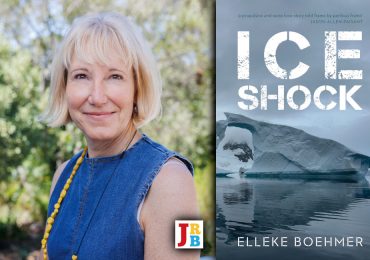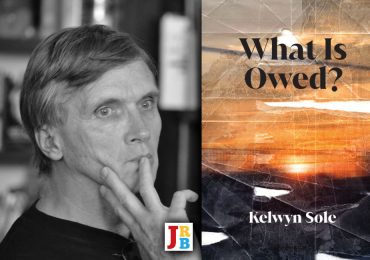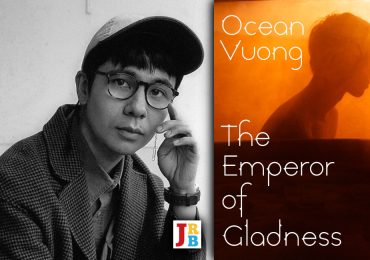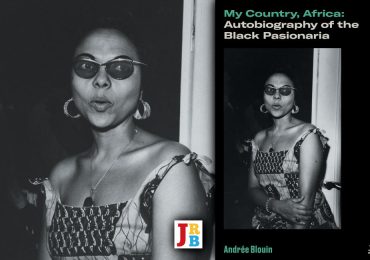Ali Smith’s seasonal quartet is a lesson in how to create novels that reflect the now in all its glory and horror, writes The JRB Editor Jennifer Malec.
Ali Smith is one of the most interesting, inventive and enjoyable experimental literary novelists currently writing in what might be called the mainstream. Her most recent books, Autumn (2016) and Winter (2017), reflect the United Kingdom’s bleak political climate, but manage to be light-hearted and high-spirited at the same time.
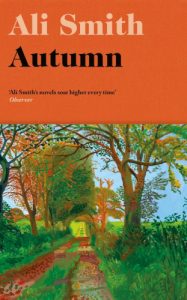
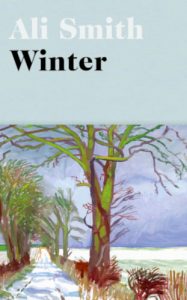 Autumn
Autumn
Ali Smith
Penguin Random House, 2016
Winter
Ali Smith
Penguin Random House, 2017
In her award-winning 2014 novel How to Be Both, Smith managed to extend her playfulness to the production of the book itself—a process not well known for its adventurousness. The novel comprises two discrete stories, one set in the present day and one in fifteenth-century Italy, and half of the books were printed with the modern story first, while the other half began in the Renaissance. Most readers—and many reviewers—were oblivious to the fact that were two editions. While the modern story is a fairly straightforward narrative, about a teenage girl in Cambridge who has lost her mother, the Italian section is in the voice of a recently-deceased 500-year-old cross-dressing fresco painter, and begins at a level of surreality and with a lack of context that is disorientating for a good few pages. Your experience of reading How to Be Both, therefore, was vastly different depending on which copy you happened to take off the shelf.
Autumn and Winter are the first two novels of a proposed seasonal quartet Smith has been planning for over twenty years. The idea crystallised when she was late in completing How to Be Both. That book ended up being produced, printed and bound in about six weeks, to meet its publishing deadline, and the quick turnaround time made Smith realise that she could write a novel of the contemporary moment and have it reach bookshops with remarkable rapidity. She decided to write four slim novels, one a year, which taken together would form some kind of whole, despite the fact that all four would be very different.
While she was completing Autumn, in June 2016, the UK voted to leave the EU, and Smith pleaded with her publisher for a month’s extension on her deadline, to allow her to adapt and update the book. Thus Autumn, published in October of that year, became the first ‘post-Brexit novel’.
The opening pages of Autumn are as untethered as the beginning of the fifteenth-century section of How to Be Both. The first sentence is a riff on Dickens—‘It was the worst of times, it was the worst of times’—followed by a description of an old man washed up on a shore, presented without context:
He looks like a punctured football with its stitching split, the leather kind that people kicked a hundred years ago. The sea’s been rough. It has taken the shirt off his back; naked as the day I was born are the words in the head he moves on its neck, but it hurts to. So try not to move the head. What’s this in his mouth, grit? it’s sand, it’s under his tongue, he can feel it, he can hear it grinding when his teeth move against each other.
What the image calls to mind for a contemporary reader, inescapably, is the distressing, all-too-frequent news reports about migrants arriving on first-world beaches. But Smith’s inspiration for the opening scene was in fact The Odyssey, in which Odysseus is shipwrecked and washes up on the shore of Scheria, the home of the Phaeacians, naked and exhausted, after twenty days struggling at sea. Although they may seem unique to their age, human horrors, like the seasons, repeat endlessly through the years.
Autumn, which was shortlisted for the Man Booker Prize, tells the story of Elisabeth Demand, a thirty-two-year-old art history lecturer in London, and her extremely elderly friend Daniel Gluck, who is in the ‘increased sleep period’ that occurs shortly before death. The novel looks back periodically on moments throughout their life together, since they first met when Elisabeth was a child.
The topical references in Autumn are extremely current, but while they are striking they are not jarring, an effect Smith achieves by means of a fastidious lack of specificity. Referring to the politically motivated murder of British Labour MP Jo Cox, which happened in June of 2016, for example, Elisabeth says:
Someone killed an MP […] A man shot her dead and came at her with a knife. Like shooting her wouldn’t be enough. But it’s old news now. Once it would have been a year’s worth of news. But news right now is like a flock of speeded-up sheep running off the side of a cliff.
As in the opening scene, Smith’s interest is in unsettling readerly or tabloidal desire for concrete detail; she deliberately shirks referential certainty even as she alludes to the contemporary moment.
A short time later, Smith sums up the public feeling in the weeks following the referendum in a brilliant piece of writing that evokes the repetitious, unceasing march of the media coverage, and the all-embracing uncertainty:
[…] All across the country, people felt it was the wrong thing. All across the country, people felt it was the right thing. All across the country, people felt they’d really lost. All across the country, people felt they’d really won. All across the country, people felt they’d done the right thing and other people had done the wrong thing. All across the country, people looked up Google: what is EU? All across the country, people looked up Google: move to Scotland. All across the country, people looked up Google: Irish passport applications. All across the country, people called each other cunts. All across the country, people felt unsafe. All across the country, people were laughing their heads off. […]
The passage goes on for another page and a half—the effect is mesmerising—and is exemplary of Smith’s writing, which deftly combines humour, poetic feeling and social commentary.
What Smith seems to be suggesting in Autumn is that while in reality we appear to live chronologically, from birth to death, in fact we construct our reality in the now by looking backwards and forwards almost constantly, sometimes within the same minute. This seemingly haphazard approach to time is the overarching theme of Smith’s work, but, as she often points out in interviews, while it may seem disorientating in a novel, it is in fact precisely how we take in the world. Autumn and Winter, therefore, become novels of the now that simultaneously demonstrate life’s temporally disorienting and diachronic nature.
Smith also takes care, in her work, to make us aware of unjustly forgotten artists and activists, often women. In How to Be Both, this is the fresco painter Francesco del Cossa, of whom so little is known Smith could believably posit that (s)he was a woman disguised as a man. In Autumn, it is Pauline Boty, Britain’s only female Pop artist and a founder of the movement. Boty was strikingly beautiful—’the Wimbledon Bardot’—and an outspoken public activist, unusual, to say the least, for a young woman in nineteen-sixties England. Her available body of work is small, much of it is lost. Her life ended tragically: when she was twenty-seven, during a routine pregnancy check-up, it was discovered she had cancer. She refused chemotherapy to save the baby, and died five months after her daughter was born. Her last work was a large painting of a woman’s behind, framed by a proscenium arch, with big red letters below it spelling the word ‘BUM’, a demonstration of the joy and irreverence in her work. In the novel, Elisabeth comes across Boty’s work in an old art catalogue, after being informed by her college tutor ‘categorically’ that there had ‘never been such a thing as a female British Pop artist’, and realises it is her lost paintings that Daniel has been vividly describing to her all her life. Smith says she just happened to come across Boty’s work while writing Autumn. We should all be extremely glad she did.
Boty’s work centred on what she called ‘nostalgia for the NOW’—a phrase quite in harmony with Smith’s work—and so echoes the poet John Keats, who despite his short years looms large in any imagining of Autumn. Smith quotes a love letter of Keats’s in Autumn’s epigraph that reflects on the relativity of time, and seems eerily to evoke the spirit of Pauline Boty: ‘If I am destined to be happy with you here—how short is the longest Life.’
Winter, meanwhile—the second in Smith’s quartet—also features a female artist, the more well known Barbara Hepworth, although the reference is more gestural. Hepworth’s striking stone sculptures, simultaneously and affectingly modern and ancient, play a minor role in the book, but at a crucial point give us a glimpse of the profound depth of feeling in the usually icy, unfeeling character of Sophia.
In Winter, four people gather in a large house in Cornwall for Christmas: Sophia Cleves, a politically conservative retired businesswoman, eccentric and ill tempered; her estranged elder sister Iris, a life-long political activist; and her son Art, who is supposed to bring his girlfriend, Charlotte, except they’ve broken up, so he hires a stranger, Lux—Croatian via Canada—to come with him and play her part. Tensions run high but, similarly to Autumn, flashbacks provide a gentle background to the present animosity.
As in Autumn, allusions to contemporary political and social happenings abound. Winter was published on 2 November 2017, almost exactly a year after Donald Trump’s election triumph, and Smith’s swift work allows her to include references to the historic worldwide Women’s March of January that year; Theresa May’s notorious ‘citizens of nowhere’ speech from October 2016; the incident where a senior male Member of the UK’s Parliament barked at a female MP like a dog; the Grenfell Tower fire; and Trump’s infamous address to the Boy Scouts of America, in which he told his audience: ‘And by the way, under the Trump administration you’ll be saying Merry Christmas again when you go shopping, believe me.’
But, through the character of Iris, Smith also reminds us of the Greenham Common Women’s Peace Camp, an anti-nuclear protest that began in 1981 with thirty-six women, grew to 70,000 women in 1983, and finally disbanded in 2000. Aside from reigniting appreciation of these women’s extraordinary fortitude, Smith seems to imply that as bad as today’s many humanitarian and political crises are, it wasn’t so long ago that the threat of a nuclear apocalypse made people feel they needed to camp out and protest for almost twenty years. Here, again, the seasonal is revealed within the now. Winter may be the season that inflicts on us the shortest day, but it is also the time of year when the daylight hours slowly begins to lengthen and grow stronger.
Like Autumn and How to Be Both, the opening pages of Winter are strange; in fact, they may be Smith’s most bewildering opening assay yet:
God was dead: to begin with.
And romance was dead. Chivalry was dead. Poetry, the novel, painting, they were all dead, and art was dead. Theatre and cinema were both dead. Literature was dead. The book was dead. […] Racism was dead. Religion was dead. Thought was dead. Hope was dead. Truth and fiction were both dead. The media was dead. The internet was dead. Twitter, instagram, facebook, google, dead.Love was dead.
Death was dead.
A great many things were dead. Some, though, weren’t, or weren’t dead yet.
Life wasn’t yet dead. Revolution wasn’t dead. Racial equality wasn’t dead. Hatred wasn’t dead.
But the computer? Dead. TV? Dead. Radio? Dead. Mobiles were dead. Batteries were dead. Marriages were dead, sex lives were dead, conversation was dead. Leaves were dead. Flowers were dead, dead in their water.
After a two-page list of things that are dead—and incongruous things that are not, which make it impossible to discern a pattern—a new chapter begins and the narrative switches to Sophia, at middle-age, being followed around her house by the floating, disembodied, yet surprisingly serene head of a child. It is only much later in the book that we realise that the initial opening was in the voice of Art, the failed blogger, who was typing words into Google followed by ‘is’, and using autocorrect to determine whether that thing is ‘dead’ or not. Thus what was a bizarre and unsettling first few pages metamorphoses into something completely simple, illustrating Smith’s skill at guiding you through the incomprehensible to the story. (The floating head, however, is never explained, although it becomes clear it is a hallucination created by Sophia’s aging, fatigued mind.)
Smith’s ability to make sense of the nonsensical is further tempered by her mastery of language. She creates extremely complex sentences that flow effortlessly. On the face of it they shouldn’t work at all, but somehow they do. She uses odd metaphors, as if she is on a crusade against cliche. In Winter I spotted at least one sentence that ran for over a page. At another point, two characters have a conversation that is split in two; we read one baffling side first and then are pleasantly surprised with the other. It’s clever, and extremely funny.
In her Goldsmiths Prize lecture, in September 2017, Smith said: ‘The novel matters because Donald Trump’. With her seasonal quartet, she is reinvigorating the novel, showing us what it can do in the age of alternative facts and interminable news tickers, an age in which reality is where we go for our plot twists—and she’s doing it in good humour. If her seasonal quartet lives up to the promise of its opening duo, it will be a lesson in how to create novels that reflect the now in all its glory and horror, and how to write in an age when the novel is dead.
- Jennifer Malec is the Editor. Follow her on Twitter.

